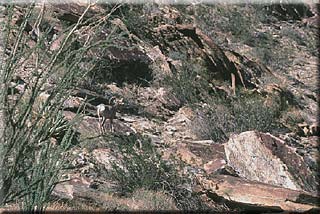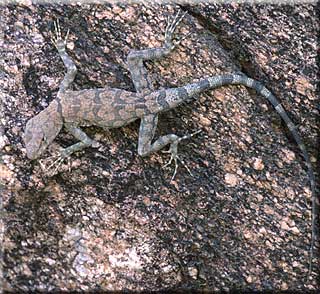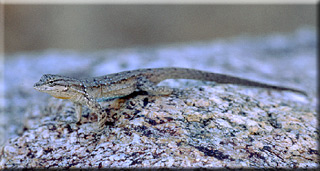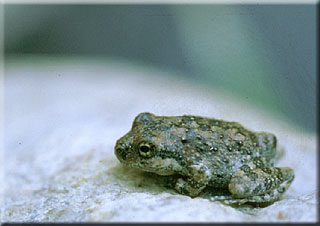|
|
|
California Deserts, August 1999
|
|
|
 |
page 4 of 7 |
 |
|
Borrego Palm Canyon
|
|
|
|
The “Borrego” in Anza-Borrego Desert State Park is Spanish for the wild
desert bighorn sheep that inhabit its rocky cliffs and canyons. I was very lucky to
happen upon a pair of bighorns meandering down Borrego Palm Canyon from the palm
oasis. This one was no more than 30 yards away, and took little notice of me as
it clambered across the boulders.
|

|
|
|
|
Here's the same bighorn heading away. Borrego Palm Canyon is the most popular trail
in the park, and in the spring it has hundreds of hikers per day. But in the heat
of the summer there were only a few of us die-hards out there. We few were not enough to scare
away the bighorns, who need to drink water nearly every day in the summer.
|

|
|
|
|
I had chosen Borrego Palm Canyon on the advice of the Lizard-Watching Guide, which
listed a wide variety of interesting species that might be found there. Many of
these are Baja California species whose range extends only about this far north.
This is a banded rock lizard, a beautiful rock-clinging
species that's generally willing to pose for photographs, though only on its
choice of rocky background.
|

|
|
|
|
Sharing the boulders with the banded rock lizards were a plethora of
granite spiny lizards. They occasionally
climbed trees like this one, but most of them stayed close to the granite crevices
into which they'd quickly escape if they saw me point my camera anywhere near them.
I had been following several of them around for more than half an hour trying to
get a decent shot before this one decided to put an end to my misery by holding
still in a palm tree for several minutes.
|

|
|
|
|
Last but not least, well, okay, last and least of the new lizard species on this trail was
the small-scaled lizard. Rather
a plain-looking little gray fellow, this one. But they were very brave around
the much larger banded rock lizards and granite spiny lizards. I saw
them do territorial push-ups and tail-wagglings just a foot or two from their
larger and potentially carnivorous cousins, and in some cases actually chase
the other lizards away.
|

|
|
|
|
A mile and a half up from the trailhead is the California desert fan palm oasis that
gives the canyon its name. In the pools of the stream running through the oasis hopped
several tiny California treefrogs, just recently developed from tadpoles.
|

|
|
|
|
|











